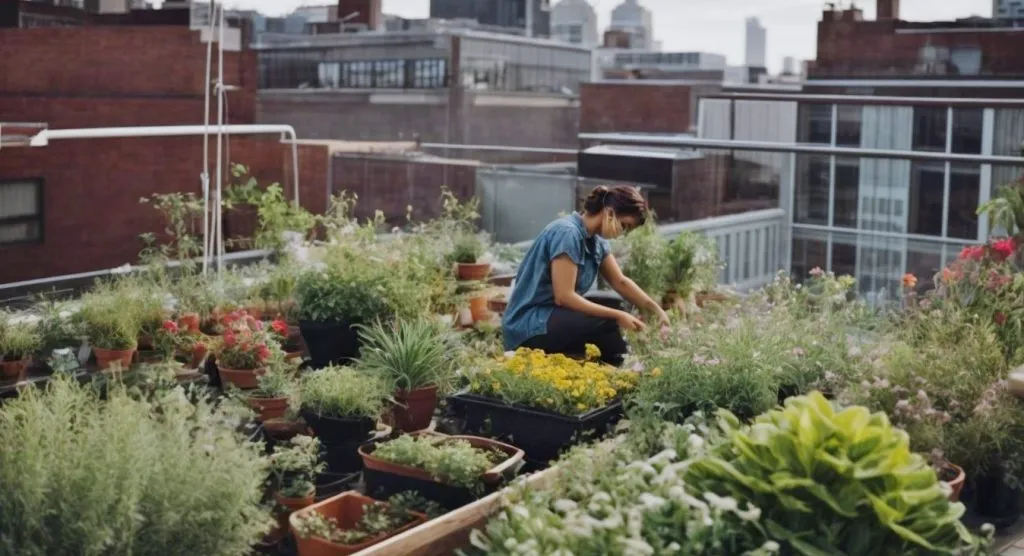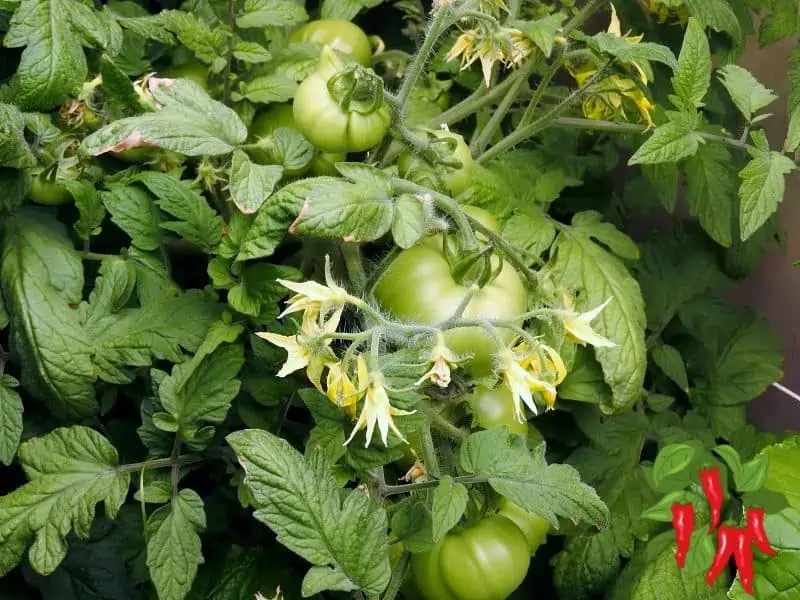This post may contain affiliate links. If you buy something from one of our links we may earn a commission. Thanks

Hey there, green thumbs! Ready to dive into seasonal rooftop garden maintenance?
Whether you’re a seasoned gardener or just starting out, we’ve got all the tips and tricks you need to keep your garden staying lush and lovely through every season. Let’s get our hands dirty and make those rooftops bloom!
Key Takeaways:
- Seasonal rooftop garden maintenance involves regular tasks like watering, pruning, and fertilizing to ensure your garden thrives in changing weather conditions.
- This routine care helps prevent plant diseases, promotes healthy growth, and keeps your rooftop oasis vibrant and productive throughout the year.
What Is a Seasonal Rooftop Garden?
Ever wondered what a seasonal rooftop garden is? Well, imagine turning the top of a building into a lively green space that changes with the seasons.
This kind of garden really makes the most out of its high-rise home, adapting to the city’s rhythms and the shifting sunlight it gets throughout the year.
Key Takeaways for Maintaining a Seasonal Rooftop Garden:
- Regular Maintenance: Schedule routine care activities like watering, weeding, and pruning to keep your garden healthy.
- Understand the Importance: Recognize that rooftop gardens face unique environmental stresses and require regular attention to thrive.
- Task Variety: Maintenance involves a range of activities from planting and fertilizing to pest control and debris cleanup.
- Seasonal Adjustments: Tailor your gardening tasks to suit the changing seasons—each one demands different care strategies.
- Self-Care Capability: With basic gardening knowledge, most rooftop garden maintenance can be managed on your own, though professional help is beneficial for complex issues.
- Safety First: Always prioritize safety by using appropriate gear and being cautious about weather conditions when working on the rooftop.
- Education Opportunities: Consider attending workshops or classes to enhance your gardening skills and knowledge.
Here’s how these sky-high gardens roll:
- Climate Savvy: They’re all about picking the right plants that can handle whatever the weather throws at them, from sizzling summers to chilly winters.
- Sunlight Smarts: Whether it’s basking in the full sun or chilling in the shade, these gardens have a plant for every spot, showing off nature’s ability to adapt right in the urban jungle.
So, a seasonal rooftop garden isn’t just a patch of green; it’s a smart, adaptable living space up in the sky!
Why Is Maintenance Important for a Seasonal Rooftop Garden?

Alright, let’s talk about why keeping up with maintenance is a big deal for your seasonal rooftop garden.
You know, maintaining a garden up on a roof isn’t just about making things look pretty—it’s essential for keeping your little slice of heaven thriving up there among the skyscrapers.
Here’s the scoop:
- Structural Safety: Regular maintenance keeps everything in check structurally. You definitely don’t want any surprises with the integrity of your garden, especially when it’s way up high!
- Beauty and Welcoming Vibes: Besides, a well-maintained garden is just nicer to be around. It turns a drab rooftop into a lush, inviting escape from the urban hustle and bustle.
- Facing Urban Challenges: In the city, your garden has to deal with pollution, cramped spaces, and some pretty wild weather sometimes. Regular maintenance helps fight off these urban gremlins.
- Expert Care: Bringing in professionals for upkeep can be a game-changer. They know their stuff when it comes to plant care, watering systems, and keeping those pesky pests in check.
Investing a bit in regular maintenance not only saves you time and effort but also keeps your garden looking top-notch all year round. Trust me, it’s worth it!
Read more: Rooftop Gardening Ideas: 7 Tips and Tricks For Beginners
What Are the Basic Maintenance Tasks for a Seasonal Rooftop Garden?
Keeping your rooftop garden in tip-top shape isn’t just about watering the plants now and then—it’s a whole routine!
Let me walk you through the basics to make sure your garden stays healthy and vibrant:
And hey, make sure you’ve got easy and safe access to your garden. A sturdy ladder or steps are a must, and while you’re at it, double-check that all your containers and systems are up to snuff with the right materials and drainage.
Happy gardening, and remember to keep it green up there!
Watering Your Seasonal Rooftop Garden
Watering your garden might sound simple, but it’s key to keeping your rooftop oasis thriving.
You’ll need a dependable water source and a solid drainage system to make sure your plants get just the right amount of moisture—no more, no less.
Here’s how to nail it:
- Consistency is King: Regular watering helps your plants grow strong and healthy. Stick to a schedule to keep them hydrated without going overboard.
- Watch Out for Overwatering: Too much water can drown your plants, leading to root rot and other soggy troubles. It’s all about finding that sweet spot where your garden’s drainage keeps up with your watering habits.
- Drainage Matters: Good drainage is a lifesaver. It stops water from pooling up and turning your garden into a breeding ground for diseases and pests.
Remember, a well-watered garden is a happy garden. Keep an eye on those watering levels and make sure your drainage is doing its job right, and you’ll be set for success!
Weeding Your Seasonal Rooftop Garden
Weeding is more than just a chore—it’s vital for keeping your rooftop garden healthy and blooming beautifully.
Those unwanted plants? They’re not just unsightly; they steal precious resources like light, water, and nutrients right out from under your cherished blooms.
Here’s why keeping up with weeding matters:
- Space for Growth: Clearing out weeds gives your plants the room they need to spread out and grow without being choked by invaders.
- Health and Vigor: A weed-free garden means your plants aren’t competing for the essentials. This keeps them robust and thriving.
- Disease and Pest Defense: Weeds can attract pests and harbor diseases. By keeping them at bay, you’re not just tidying up—you’re protecting your garden from potential outbreaks.
So grab your gloves and get to it. Regular weeding makes all the difference in keeping your garden space clean, healthy, and ready for growth. Happy weeding!
Fertilizing Your Seasonal Rooftop Garden
Think of fertilizing as giving your rooftop garden a boost of vitamins—it’s all about feeding your plants the nutrients they need to grow strong and healthy.
Just like us, plants need a balanced diet to flourish, and that’s where fertilizer comes into play.
Here’s the lowdown on getting fertilization right:
- The Essentials: Plants need goodies like nitrogen for leaf growth, phosphorus for roots and blooms, and potassium for overall health. Together, these nutrients ensure your plants aren’t just surviving but thriving.
- Tailored Feeding: Not all plants are alike; they need different nutrients at different times. Setting up a fertilization schedule that matches the specific needs of your garden will keep your plants at their best.
- Keep an Eye Out: Regularly checking on your plants and soil will tell you when it’s time to feed them again. It’s like being a plant detective, looking for clues to keep them happy!
Fertilizing isn’t just routine; it’s essential to harvest the lush, vibrant growth that makes your rooftop garden a true standout.
Pruning Your Seasonal Rooftop Garden
Alright folks, let’s talk about pruning. It’s not just about making your garden look good—it’s about keeping your plants healthy and happy.
Up on the roof, space is at a premium, and making sure every plant gets its fair share of sunlight is crucial.
Here’s why you should keep those shears handy:
- Sunlight Access: Trimming those branches lets the sunshine spread evenly across your garden. It’s all about giving every plant a chance to soak up some rays and do its photosynthesis thing.
- Making Space: When you prune your plants, you’re helping to shape your garden’s look and feel, making sure everything fits well and looks great.
- Healthier Plants: Cutting back the overgrown parts means your plants can focus on growing stronger and healthier. It’s like directing their energy where it’s most needed.
So, grab your pruning shears and get trimming. Keeping your garden pruned is a big part of having a successful rooftop garden.
It’s pretty satisfying too, seeing how neat and tidy everything looks after a good prune!
Pest Control in Your Seasonal Rooftop Garden
Now, let’s chat about pest control—a real must for keeping your rooftop garden healthy.
We’re all about doing this the natural way, avoiding harsh chemicals so your garden thrives in a way that’s good for the environment.
Here’s the lowdown on keeping those pests in check:
- Beneficial Bugs: Welcome the good guys like ladybugs and lacewings into your garden. They munch on the bad bugs like aphids and caterpillars, helping keep your plants healthy.
- Spot ‘Em Early: Keeping an eye out for troublemakers like spider mites, whiteflies, and thrips is key. Catching these pests early can save you a lot of hassle down the road.
- Healthy Plants Fight Back Better: Healthy plants have a fighting chance against pests. Make sure they’re getting the right mix of nutrients, water, and sunlight. It’s like giving your plants their own armor against pest attacks.
By focusing on natural pest control methods and keeping your plants robust, you’re setting up your garden for success.
300 Live Ladybugs – Good Bugs – Guaranteed Live Delivery!
Remember, a little observation and preventive care can go a long way in keeping those pesky pests at bay!
When Should Maintenance Be Done for a Seasonal Rooftop Garden?

Caring for a seasonal rooftop garden is a year-round commitment, with each season bringing its own set of tasks to ensure your garden stays healthy and vibrant.
Stick to these seasonal tips, and you’ll keep your rooftop garden lush and productive all year round.
Each plant will get just the right care it needs to thrive, no matter the season.
Here’s the Rundown for Year-round Rooftop Garden Upkeep:
Seasonal rooftop garden maintenance should be conducted throughout the year, with specific tasks scheduled in spring, summer, fall, and winter to address seasonal requirements and ensure the garden’s health and vitality.
- Spring: It’s all about fresh starts. Prune away the old, weed out the intruders, and throw in some fertilizer to wake up those blooms and new growth.Spring breathes new life into your garden, making it a critical time for setting the stage for the rest of the year.
- Pruning and Cleaning: Start by pruning back any dead or overgrown branches to promote new growth. Clear out old leaves and debris.
- Weeding and Fertilizing: Get rid of weeds before they can take hold, and apply fertilizer to give your plants a boost after the winter dormancy.
- Planting: It’s also a great time to introduce new plants that thrive in your climate’s spring conditions.
- Summer: Keep those plants happy with regular watering and pest control. Don’t forget to provide some shade to beat that intense summer sun.Summer requires diligent care to keep plants thriving in the heat.
- Watering: Implement regular, deep watering to help plants withstand the heat. Consider a drip irrigation system to conserve water and ensure deep soil moisture.
- Pest Control: Keep an eye out for pests common in the warmer months and tackle them with natural methods.
- Shade Provision: Provide shade to sensitive plants to protect them from the midday sun, using options like shade cloths or strategically placed plants that provide natural cover.
- Fall: Time to get your garden ready for the cooler days. Plant those fall crops, cozy up those delicate plants, and clear out the old debris.As temperatures begin to drop, preparing your garden for the colder months is key.
- Planting Seasonal Crops: Plant crops suited for cooler weather.
- Protection: Begin to protect sensitive plants from the decreasing temperatures.
- Preparation for Winter: Clear out debris and dead plants, and apply mulch to insulate plant roots for the coming cold.
- Winter: Protect your plants from the harsh cold. Make sure your garden’s drainage is in top shape and try to keep off the beds to avoid compacting the soil.Winter care focuses on protection and preparation for the spring to come.
- Frost Protection: Protect vulnerable plants from frost with covers or by moving them to sheltered areas.
- Drainage Check: Ensure that your garden’s drainage is effective, especially during wetter winter conditions, to avoid waterlogging.
- Minimal Interference: Reduce foot traffic and general disturbance in the garden to avoid damaging dormant plants.
By keeping up with these tasks through the seasons, you’ll ensure your garden not only survives but thrives. A solid plan throughout the year is your best bet for a garden that’s not just surviving but flourishing!
What Are the Tools and Supplies Needed for Seasonal Rooftop Garden Maintenance?
To keep your seasonal rooftop garden looking its best, you’ll need a few key tools and supplies:
- Watering Can or Hose: Hydration is crucial, especially during those dry spells. Make sure you have a reliable watering can or hose to keep your plants well-watered.
- Hand Trowel and Garden Gloves: For all the digging, planting, and weeding, a sturdy hand trowel and a pair of durable garden gloves are must-haves.
- Fertilizer or Compost: These are essential for providing your plants with the nutrients they need to grow strong and produce vibrant flowers and healthy foliage.
- Pruning Shears: Handy for cutting back overgrown branches and shaping your plants, pruning shears help encourage healthier, bushier growth.
- Natural Pest Control Methods: To keep pesky insects at bay without resorting to harsh chemicals, natural pest control methods are the way to go. They help maintain your garden’s health and keep it looking great.
With these tools and supplies, you’re well on your way to nurturing a thriving rooftop garden that’s not only a treat for the eyes but also a healthy ecosystem for your plants.
Watering Can or Hose
Keeping your rooftop garden lush and healthy starts with the right watering tools. A watering can or hose is vital for making sure your plants get just the right amount of water.
2-Gallon Tru-Stream Outdoor and Indoor 100% Recycled Plastic Watering Can
Here’s the lowdown:
- Controlled Watering: A watering can is perfect for giving your plants a gentle shower, especially if you want to target specific areas or plants without making a mess.
- Wide Coverage: If you’ve got a larger space, a hose with a nozzle attachment is your best bet. It lets you cover more ground quickly and can be adjusted for different watering needs.
It’s super important to get the watering just right—too much and you risk root rot, too little and your plants might not thrive.
With a watering can or hose, you can easily adjust how much water your plants get, making sure they grow healthy and strong.
Hand Trowel or Garden Gloves
Fiskars Ergo Trowel – Heavy Duty Gardening Hand Tool
When you’re up to your elbows in garden work, don’t forget your hand trowel and garden gloves—they’re essentials!
Whether you’re planting, weeding, or just giving your rooftop oasis a little TLC, these tools make all the difference.
- Hand Trowel: This little tool is a powerhouse for planting. It’s perfect for snugly tucking in small plants, bulbs, and seeds, making sure they’re set just right for strong growth. It’s also great for scooping and transplanting without harming those tender young roots.
- Garden Gloves: Ever get a scratch from a hidden thorn or a rash from some pesky plant? Garden gloves are your first line of defense. They keep your hands safe from scratches, cuts, and irritants, so you can dig in without worry.
Together, a hand trowel and garden gloves keep your gardening smooth and safe, letting you focus on the fun parts of rooftop gardening.
Fertilizer or Compost
Dr. Earth Organic 5 Tomato, Vegetable & Herb Fertilizer
If you want your rooftop garden to thrive, you can’t overlook the importance of fertilizer or compost.
These goodies are like a superfood smoothie for your plants, packing in all the nutrients they need to grow strong and healthy.
- Nourishment: Using fertilizer or compost is key to giving your plants the best shot at growth. These additions feed your soil, making it rich and fertile. Whether you choose a quick-acting synthetic fertilizer or go all-natural with compost, you’re providing essential nutrients that help your plants flourish.
- Soil Health: Good soil isn’t just about dirt; it’s living and breathing. By adding compost, you improve its structure and boost its nutrient content. This doesn’t just help your current plants—it sets the stage for a sustainable garden that keeps on giving.
- Harmony in the Garden: Fertilizer and compost do more than just feed plants; they create a balanced soil ecosystem that supports all sorts of life, from tiny microbes to your tallest tomatoes.
Remember, healthy soil equals healthy plants. So give your garden a little love with the right mix of fertilizer or compost, and watch your rooftop haven bloom!
Pruning Shears
No rooftop garden toolkit is complete without a trusty pair of pruning shears. These aren’t just for snipping and shaping; they’re essential for keeping your plants healthy and your garden looking sharp.
- Precision and Health: Pruning shears let you get in close and make precise cuts, which is perfect for cutting away dead or diseased foliage and preventing overcrowding. This not only keeps your plants looking good but also healthy by eliminating places where diseases could spread.
- Size and Shape Control: With a good pair of shears, you can easily control the size and shape of your plants. This helps prevent them from hogging all the space and resources, giving every plant in your garden a fair chance to shine.
- Stress Reduction: Clean cuts are important because they heal faster and reduce stress on the plant, minimizing the chances of disease sneaking in through jagged or torn sections.
- Sunlight and Air Flow: Proper pruning also improves air circulation and increases sunlight exposure, which are vital for strong, vibrant growth.
Invest in a solid pair of pruning shears, and you’ll find they’re invaluable for maintaining the health and beauty of your rooftop garden. Happy pruning!
Natural Pest Control Methods
Keeping your rooftop garden pest-free doesn’t mean you have to resort to harsh chemicals.
Natural pest control methods are a fantastic way to keep those bugs at bay while keeping your garden healthy and eco-friendly.
- Companion Planting: This is one of the cleverest ways to protect your plants. By placing certain plants together, you can naturally repel pests. For instance, marigolds are great at keeping aphids away, while basil can attract beneficial bees and predatory insects that help control unwanted pests.
- Biological Pest Control: This method involves bringing in nature’s own pest controllers. Introducing beneficial insects like ladybugs or lacewings into your garden can make a huge difference. These friendly bugs munch on harmful pests, helping to keep your garden’s ecosystem balanced and healthy.
By using these natural methods, you not only avoid the pitfalls of chemical treatments but also support a vibrant, natural ecosystem right on your rooftop.
Tackling Common Problems in a Seasonal Rooftop Garden

Keeping your rooftop garden in top shape means being on the lookout for issues like overwatering, underwatering, nutrient deficiencies, pests, and diseases. Addressing these effectively is crucial for maintaining the health and vibrancy of your plants.
- Watering Woes: Too much water can cause root rot and wash away essential nutrients, while too little can stunt plant growth and cause wilting. To get it just right, keep an eye on soil moisture levels with a reliable soil moisture meter.
- Nutrient Balance: If your plants start showing signs like yellowing leaves or lackluster blooms, it might be a nutrient issue. Setting up a fertilization schedule that meets the specific needs of your plants can help correct and prevent these deficiencies.
- Pest and Disease Watch: Natural pest control methods, such as introducing beneficial insects, can effectively keep pest populations under control without damaging your ecosystem. Regularly check your plants for any signs of disease—like unusual spots or fungal growth—and treat them quickly with suitable fungicides if needed.
By staying vigilant and proactive, you can keep common garden problems at bay and ensure your rooftop garden remains a thriving sanctuary.
Underwatering: A Challenge for Rooftop Gardens
- Underwatering can cause significant stress to plants in a rooftop garden, leading to wilting, stunted growth, and overall vitality loss.
- Consistent watering practices are crucial to avoid these negative effects and keep your garden flourishing.
Symptoms of Dehydration
- Plants lacking adequate water struggle with photosynthesis, showing visible distress through symptoms like leaf browning and premature leaf drop.
- This not only diminishes the visual charm of your garden but also hampers the health and productivity of your plants.
Monitoring and Watering Adjustments
- Regularly checking soil moisture levels is key to effective garden management. Adjusting your watering schedule based on these readings ensures that each plant receives the hydration it needs to thrive.
- This proactive approach helps maintain optimal soil moisture, crucial for healthy plant growth.
Choosing Drought-Resistant Plants
- Incorporating plants that naturally withstand dry conditions can greatly enhance your garden’s resilience.
- These drought-tolerant varieties require less frequent watering, reducing the risk of underwatering and ensuring long-term plant health and vigor.
By implementing these strategies, you can protect your rooftop garden from the risks associated with underwatering, promoting a lush and vibrant environment.
Addressing Nutrient Deficiencies in Rooftop Gardens
Making your own compost can help avoid nutrient deficiencies in your garden. It does not require a compost heap. Instead, use a compost tumbler as a practical solution for rooftop gardens.
Dual Chamber Compost Tumbler – Easy-Turn, Fast-Working System
Impact of Nutrient Deficiencies
Nutrient deficiencies can significantly affect the growth and health of plants in a rooftop garden. When essential nutrients like nitrogen, phosphorus, or potassium are lacking, plants may exhibit stunted growth, yellowing leaves, and reduced vigor, which can diminish their overall productivity.
Importance of Soil Testing and Fertilization
Regular soil testing is vital for maintaining nutrient balance. These tests can pinpoint exactly which nutrients are deficient in your garden’s soil. Based on the results, you can apply the appropriate fertilizers or soil amendments that provide the necessary nutrients to promote healthy plant growth.
Using Organic Fertilizers
Organic fertilizers and compost are excellent choices for enriching your soil. They not only supply essential nutrients but also improve soil structure and help maintain long-term soil fertility. These natural options release nutrients slowly, ensuring a steady supply that supports ongoing plant health.
Companion Planting for Nutrient Enhancement
Companion planting, especially incorporating nitrogen-fixing legumes, can naturally enhance soil nutrient levels. These plants help increase nitrogen availability in the soil, which benefits the surrounding plants and boosts overall garden productivity.
By addressing nutrient deficiencies with these targeted strategies, you can ensure your rooftop garden remains vibrant and productive, supporting robust plant growth and development.
Managing Pests and Diseases in Rooftop Gardens
Threats to Plant Health Pests and diseases pose significant risks to the health of plants in a rooftop garden.
Without proper management, common issues like aphids, spider mites, powdery mildew, and fungal infections can escalate, potentially devastating your garden.
Prevention and Early Detection Preventive measures are key to keeping your garden healthy.
Regular plant inspections can help catch early signs of trouble before they become severe.
Maintaining cleanliness and ensuring good air circulation around your plants can also reduce the risk of pest infestations and disease spread.
Spotting Signs of Trouble Be vigilant for symptoms such as yellowing leaves, stunted growth, distorted foliage, or the presence of pests. Early detection is critical for effective management.
Effective Treatment Options Once you identify a problem, act quickly to control it.
Options include organic solutions like neem oil and insecticidal soaps, which are effective against a range of pests and diseases while being safer for the environment than chemical treatments.
For severe infestations, you may need to consider stronger remedies tailored to specific problems.
By implementing these strategies, you can protect your rooftop garden from pests and diseases, ensuring your plants remain healthy and vibrant.
Tips for Maintaining a Seasonal Rooftop Garden

Maintaining a vibrant seasonal rooftop garden involves several key practices that ensure your plants are healthy and your space looks great. Here are some essential tips:
Optimize Sunlight Exposure
Sunlight is crucial for your plants’ growth. Arrange your garden layout so that all plants receive the optimal amount of sunlight throughout the day.
This might mean positioning some plants higher than others or using movable planters to chase the sun.
Maximize Space Utilization
Rooftop gardens often have limited space, so think vertically! Using hanging baskets, wall planters, or trellises not only saves floor space but also adds an interesting dimension to your garden.
This approach allows you to grow more plants and can even create microclimates for different types of plants.
Ensure Proper Drainage
Good drainage is vital to prevent waterlogging, which can cause root rot and kill your plants.
Make sure your planting containers have adequate drainage holes, and consider layering gravel or pebbles at the bottom of pots to improve water flow.
If your rooftop doesn’t naturally slope, create a gradient to help guide excess water away from plant roots.
Consistent Maintenance Schedule
Keep a regular gardening schedule. Regular weeding, pruning, watering, and monitoring for pests and diseases are all essential tasks that keep your garden thriving.
Setting weekly and monthly reminders can help you stay on top of these tasks without feeling overwhelmed.
By following these tips, you can create and maintain a beautiful and productive seasonal rooftop garden that provides a lush, green escape in the urban environment.
Seasonal Rooftop Garden Maintenance FAQs
Got questions about keeping your rooftop garden in tip-top shape? You’re in the right place.
Whether you’re a green thumb guru or just starting, rooftop gardening has its quirks.
We’re here to break down the what, why, and how of keeping your garden lush all year round.
So, let’s dig into these FAQs and help you keep that garden blooming beautifully!
Q: What is seasonal rooftop garden maintenance?
A: Seasonal rooftop garden maintenance is all about keeping your garden in top shape throughout the year. It involves watering, planting, pruning, and just making sure everything’s looking good and healthy no matter the season.
Q: Why is seasonal maintenance important for rooftop gardens?
A: Well, since rooftop gardens are right up there exposed to all sorts of weather, they need a bit more TLC. Regular maintenance helps keep everything running smoothly, ensures your plants are healthy, and keeps the garden looking great.
Q: What are some common tasks involved in seasonal rooftop garden maintenance?
A: There are a few things you’ll want to keep on top of:
- Planting new seeds or plants that fit the season.
- Weeding, so those pesky invaders don’t steal resources.
- Trimming plants to keep them healthy and in shape.
- Watering regularly, especially when it’s dry.
- Fertilizing to give your plants the nutrients they crave.
- Cleaning up leaves and debris to keep things tidy.
- Checking for pests and diseases and dealing with them quickly.
Q: How often should seasonal rooftop garden maintenance be performed?
A: It’s best to do a thorough check and update about four times a year with each season change. But remember, some things like watering and weeding might need your attention more often depending on the weather and how fast things are growing.
Q: Can I do seasonal rooftop garden maintenance on my own?
A: Absolutely, you can handle it if you’ve got a bit of gardening know-how. But if you run into something tricky or you’re not sure about how to care for specific plants, it might be a good idea to call in a pro. Also, keep an eye out for local gardening workshops—they can be super helpful.
Q: Are there any safety precautions to keep in mind while performing rooftop garden maintenance?
A: Definitely. Safety first, right? Make sure you’re wearing proper shoes, use a sturdy ladder to get up there, and try not to work on the roof when it’s wet or windy. Watch out for slippery spots or loose tiles, and always be cautious.
Visit my Amazon Influencer Page for videos and gardening products Grow Your Own Garden














